|
|
|
Sort Order |
|
|
|
Items / Page
|
|
|
|
|
|
|
| Srl | Item |
| 1 |
ID:
149889
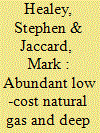

|
|
|
|
|
| Summary/Abstract |
This paper analyzes the implications of the natural gas revolution on the US’ ability to achieve deep GHG emissions reductions of 80% below 2005 levels by 2050. It uses a hybrid energy-economy model to test how prevailing low US natural gas prices influence the magnitude of the required carbon price needed to achieve this target. While the paper finds in general that lower gas prices resulting from plentiful gas necessitate a higher carbon price to achieve this target, informing firms and consumers in advance about the magnitude of the future carbon price can lower the necessary level.
|
|
|
|
|
|
|
|
|
|
|
|
|
|
|
|
| 2 |
ID:
149886
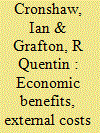

|
|
|
|
|
| Summary/Abstract |
We review the economic benefits and external costs of unconventional gas production (UCG) in the United States from a policy perspective. Based on an overview of state regulation in Pennsylvania, a state that has witnessed very rapid growth of gas production over the past 5 years, and global experiences we present 10 key principles that are proposed to reduce the risks and to increase the net rewards of UCG. Application of these principles has the potential to reduce the risks of UCG, especially at a local level, while maximizing the benefits of gas developments.
|
|
|
|
|
|
|
|
|
|
|
|
|
|
|
|
| 3 |
ID:
150349


|
|
|
|
|
| Summary/Abstract |
In the US, the shale gas revolution ensured that the development costs of unconventional natural gas plummeted to the levels of $2–3/Mcf. This success has motivated the development of shale gas in other regions, including Australia and Europe. This study, focussing primarily on aspects of economic impact analysis, estimates the development costs of shale gas extraction in both Australia and Europe, based on both direct and fiscal costs, and also suggests policy initiatives.
|
|
|
|
|
|
|
|
|
|
|
|
|
|
|
|
| 4 |
ID:
117338
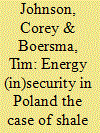

|
|
|
|
|
| Publication |
2013.
|
| Summary/Abstract |
The large scale extraction of natural gas from shale rock layers in North America using hydraulic fracturing, or "fracking", has prompted geologists, economists and politicians in various parts of the world to ask whether there are new reserves of this precious resource to be found under their soils. It has also raised a host of questions about the potential environmental impacts of extracting it. Drawing on research on both sides of the Atlantic, this paper assesses the most pressing issues for research and policy makers related to shale gas extraction. The paper first provides a survey of environmental and economic issues related to shale gas. It then turns to a case study of Poland, whose policy makers have been among the most fervent proponents of shale gas development in the European Union. We examine the status of shale gas extraction in that country and what the barriers are to overcome before commercial extraction can in fact take place, if at all.
|
|
|
|
|
|
|
|
|
|
|
|
|
|
|
|
| 5 |
ID:
120564


|
|
|
|
|
| Publication |
2013.
|
| Summary/Abstract |
FOR MORE THAN HALF A CENTURY, global hydrocarbon production concentrated around the Middle East. For many years, the traditional oil and gas meridian ran along the axis: Yamal-Turkmenistan-Iran-Iraq-Kuwait-Saudi Arabia. But today we are witnessing a radical change in the situation: the center of world oil production is rapidly shifting to the Western Hemisphere. The new energy axis runs from the Canadian province of Alberta through the American states of North Dakota and Texas, and on through Mexico, Venezuela and Brazil.
|
|
|
|
|
|
|
|
|
|
|
|
|
|
|
|
| 6 |
ID:
136207


|
|
|
|
|
| Summary/Abstract |
Shale gas development in China can generate great potential economic benefits, but also poses serious environmental risks. In this paper, we offer a macro assessment of the environmental risks of shale gas development in China. We use the US experience to identify the nature of shale gas development activities and the types of potential burdens these activities may create. We then review the baseline environmental conditions and the effectiveness of environmental regulations in China and discuss the implications of these China-specific factors for risk assessment. We recommend China to conduct a strategic environmental assessment and to consider sector-specific environmental regulations.
|
|
|
|
|
|
|
|
|
|
|
|
|
|
|
|
| 7 |
ID:
171495


|
|
|
|
|
| Summary/Abstract |
This paper reports on a critical discourse analysis on a collection of international scientific journal articles, which are a critical edge of social epistemology. At the textual surface, the analysis finds that China's shale gas (SG) is compared most frequently with coal and energy imports but rarely with conventional natural gas (CNG) and coalbed methane (CBM), representing a prominent structure of epistemological dominance and ignorance. Situated in this structure there are four prevailing, albeit defective, reasoning forms. The prevalence of those forms suggests that there is a “knowledge deficit” on the comparative advantage of China's SG. This deficit concretely refers to that, the attention paid to the comparative advantage of China's SG toward CNG and CBM, the number of lifecycle-comparisons between energies, and the knowledge about the US shale gas boom, are significantly insufficient. China's energy mix, air quality and energy dependence, the conspicuousness of energy burning, and the nature of human thinking are interwoven factors of this deficit. The epistemological structure and thus the “knowledge deficit” are unfavorable for optimizing China's SG strategy and may delay natural gas' penetration into China's energy mix. This paper, especially its mental model representation, is awareness/introspection provoking to researchers and policy makers.
|
|
|
|
|
|
|
|
|
|
|
|
|
|
|
|
| 8 |
ID:
186484


|
|
|
|
|
| Summary/Abstract |
Shale gas exists in abundant quantities around the world and could augment conventional natural gas supplies. However, shale gas exploration through the fracking process is associated with negative connotations and is opposed in many countries because of the perceived environmental impacts including water contamination and competition with other water demands. In this context, the contribution of this work is to analyze the long-term impact of fracking water demand on water availability and possible contamination in Brazil. The objective is to estimate the long-term impacts of shale gas development in Brazil considering the water demand and propose regulations to address water withdrawal and contamination concerns based on best practices from around the world as a way forward. The study demonstrates that competition for water by prospective fracking activities in Brazil in comparison to available water resources and other water demands in associated hydrological basins is insignificant. Furthermore, an analysis of policy and regulations identify policy and regulatory recommendations that may ameliorate public concerns about fracking impact on water by enforcing compliance from exploration and production companies. Following this study, other countries can estimate their shale gas exploration realities to determine the impact of fracking impact on water resources.
|
|
|
|
|
|
|
|
|
|
|
|
|
|
|
|
| 9 |
ID:
134137


|
|
|
|
|
| Publication |
2014.
|
| Summary/Abstract |
The recent geopolitical events, and primarily those unfolding along the West-Russia trajectory, have dramatically changed the forecast of how long the EU can continue using Russian energy resources. The European countries wish to slowly free themselves from their energy dependence on Russia and make new adjustments to the conceptual approaches to this problem. In particular, the EU has been actively fortifying its position in the Black Sea-Caspian Region by dividing it into two key strategic components-the Southern Caucasus and the Caspian.
The Eastern Partnership Program, which extends to Georgia, Ukraine, Azerbaijan, Moldova, Armenia, and Belarus, has implied close cooperation between these post-Soviet countries and the EU at all levels from the very beginning. The Europeans find these countries easier to understand in historical and cultural terms than the Central Asian countries.
The energy-rich countries (Azerbaijan, Turkmenistan, and Iran) and countries with considerable transit capacities (Turkey and Georgia) have found themselves in the epicenter of the European establishment's attention. At the beginning of 2014, several important new projects for the South Caucasian Region were articulated (Nabucco, Nabucco West, TAP, Shah Deniz-2, and others).
The EU is now faced with making an urgent choice between its former dependence on Russia or undertaking gradual modernization by finding new energy partners. In this respect, the most radical part of European society is willing to engage in any economically promising cooperation (in the form of low energy prices), as long as it is not with Russia or the U.S.
The rest of society holds a more moderate position in favor of diversifying suppliers; it is not against either Russian energy resources or American shale gas, but is also considering alternative energy sources.
It should be noted that, on the whole, the EU inclines more toward the second scenario.
However, after making its South Caucasian choice, the EU is not rushing to invest huge sums in the implementation of the energy projects that, as already noted, are being actively discussed by some countries of the region. Moreover, the American factor continues to play an important role: the U.S. is striving to squeeze Russia out of the European energy zone. In so doing, it is clearly striving to monopolize the European regional gas market.
|
|
|
|
|
|
|
|
|
|
|
|
|
|
|
|
| 10 |
ID:
175257
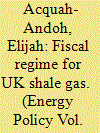

|
|
|
|
|
| Summary/Abstract |
The UK is believed to hold prolific reserves of shale gas; the quality of which has been compared and sometimes branded superior to the much successful US shale plays. Nonetheless, after more than ten years since the 13th Onshore Licensing Round, the fracking industry is said to have benefited from just £400 million - £500 million of estimated investments and only one partially fracked well with yet an uncertain fate of commercial production. This paradox motivated the current research. Based on a discounted cash flow model, the economic feasibility of the tax regime was evaluated with a special interest in the pad allowance [PA], a major incentive of the fiscal regime. We find that the design of the fiscal regime well achieves the Government's financial objectives, but fails to support shale gas investments at lower gas prices. PA introduces further variability in investor cash flows, ultimately defeating the ethos of the incentive. We propose a reduction in the overall tax rate from 40% to no more than 21%; a removal of the additional tax charge (Supplementary Charge) and an amendment of PA rules to; (1) allow an extension of RFES to PA; (2) permit transfer of activated PA across companies in the same group; and (3) redefine capital expenditure to include intermediate well retirement costs necessary to drill new wells to stimulate production. Such a tax strategy would simplify and align the UK fiscal regime with practices across the US, China, Algeria and Canada. Importantly, it would better match the risk of shale gas investments to its rewards and could better attract investments. We recommend the strategy for emerging unconventional oil and gas producing countries for an efficient design of their fiscal regimes.
|
|
|
|
|
|
|
|
|
|
|
|
|
|
|
|
| 11 |
ID:
112925


|
|
|
|
|
| Publication |
2012.
|
| Summary/Abstract |
Natural gas is widely considered to be the crucial "bridging fuel" in the transition to the low-carbon energy systems necessary to mitigate climate change. This paper develops a case study of the shale gas industry in British Columbia (BC), Canada to evaluate this assumption. We find that the transition fuel argument for gas development in BC is unsubstantiated by the best available evidence. Emissions factors for shale gas and LNG remain poorly characterized and contested in the academic literature, and context-specific factors have significant impacts on the lifecycle emissions of shale gas but have not been evaluated. Moreover, while the province has attempted to frame natural gas development within its ambitious climate change policy, this framing misrepresents substantive policy on gas production. The "transition fuel" and "climate solution" labels applied to development by the BC provincial government risk legitimizing carbon-intensive gas development. We argue that policy makers in BC and beyond should abandon the "transition fuel" characterization of natural gas. Instead, decision making about natural gas development should proceed through transparent engagement with the best available evidence to ensure that natural gas lives up to its best potential in supporting a transition to a low-carbon energy system.
|
|
|
|
|
|
|
|
|
|
|
|
|
|
|
|
| 12 |
ID:
177142


|
|
|
|
|
| Summary/Abstract |
Increasing concerns about the water-related impacts posed by shale gas development have prompted the need for protecting water resources. Determining the preferences for shale water management is critical for the design and implementation of cost-effective management strategies. Nevertheless, the public's multidimensional preferences for different aspects of the shale water management have not yet been addressed in shale-related studies. To this end, a choice experiment is used to examine the preference heterogeneity for shale water management that would improve water consumption, wastewater recycling, and water quality monitoring in Fuling shale gas field, southwest China. Results from a random parameter logit model show that residents' average WTP is 45.76 yuan per year per household for the improvements of all water-related attributes to the highest qualitative level. The accumulated welfare gains indicate that local government could increase the gas price by 0.058 yuan per cubic meter for implementing water management strategies. We also find considerable preference heterogeneity in both systematic and random utility components, and average WTP is significantly influenced by the respondent's demographical and psychological characteristics. The findings highlight the potential to find socially acceptable ways to promote shale water management and provide insight into the relevant policymaking process.
|
|
|
|
|
|
|
|
|
|
|
|
|
|
|
|
| 13 |
ID:
135492


|
|
|
|
|
| Summary/Abstract |
Ensuring energy security is imperative to sustain and upscale India’s growth story and there is an obvious need to adopt integrated approaches to energy policymaking. The article argues the need to diversify the supply side of India’s growing energy needs and underlines the importance of India-US cooperation on energy security with a special focus on clean energy. The paper assesses the various modalities of India-US Energy cooperation and argues in favour of deepening energy cooperation with the US
|
|
|
|
|
|
|
|
|
|
|
|
|
|
|
|
| 14 |
ID:
113146
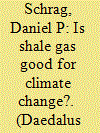

|
|
|
|
|
| Publication |
2012.
|
| Summary/Abstract |
Shale gas is a new energy resource that has shifted the dominant paradigm on U.S. hydrocarbon resources. Some have argued that shale gas will play an important role in reducing greenhouse gas emissions by displacing coal used for electricity, serving as a moderate-carbon "bridge fuel." Others have questioned whether methane emissions from shale gas extraction lead to higher greenhouse gas emissions overall. I argue that the main impact of shale gas on climate change is neither the reduced emissions from fuel substitution nor the greenhouse gas footprint of natural gas itself, but rather the competition between abundant, low-cost gas and low-carbon technologies, including renewables and carbon capture and storage. This might be remedied if the gas industry joins forces with environmental groups, providing a counterbalance to the coal lobby, and ultimately eliminating the conventional use of coal in the United States.
|
|
|
|
|
|
|
|
|
|
|
|
|
|
|
|
| 15 |
ID:
126961
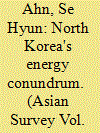

|
|
|
|
|
| Publication |
2013.
|
| Summary/Abstract |
This article examines North Korea's current energy security situation and suggests several possible energy options for the country to overcome its energy shortage crisis. The study investigates the serious problems of North Korea's heavily China-dependent energy structure, and ultimately proposes ensuring North Korea's energy security by promoting various natural gas aid programs over the longer term.
|
|
|
|
|
|
|
|
|
|
|
|
|
|
|
|
| 16 |
ID:
123731


|
|
|
|
|
| Publication |
2013.
|
| Summary/Abstract |
With the highest shale gas reserves worldwide and huge need for energy, the Chinese government has introduced many incentives to accelerate the development of shale gas, including subsidies and reduction or waiver of the related fees or taxes. However, the challenges posed by a lack of advanced technologies, environmental protection, a shortage of water in quantity and a knowledge of how to develop a good industry-local community relationship are anticipated in the realization of the predicted golden age of the Chinese shale gas industry. Based on the particular situation and available resources in China, and with reference to the experiences in countries with a developed shale gas industry (such as the U.S.A.) and suggestions by the International Energy Agency, recommendations about the choices facing China can be summarized as follows: allowing foreign investors directly to hold exploration and mining rights in shale gas could facilitate the obtainment of advanced technologies; the improvement of the regulatory arrangements related to environmental protection could make developers more responsible; prompting developers to improve their water-use efficiency could help in not worsening the water supply to some extent; and SLO-based mechanism guidance could be helpful in developing a mutual-trust and -benefit relationship between the shale gas industry and the local community
|
|
|
|
|
|
|
|
|
|
|
|
|
|
|
|
| 17 |
ID:
150668
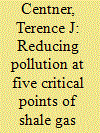

|
|
|
|
|
| Summary/Abstract |
While the public and governments debate the advisability of engaging in shale gas production, the United States has proceeded to develop its resources with an accompanying remarkable increase in natural gas production. The development of shale gas has not been without problems, and some countries have decided that shale gas production should not proceed until more is known about the accompanying health issues and environmental damages. From experiences in the United States, careful consideration of five critical points relating to shale gas production can form the basis for developing strategies for reducing discharges of pollutants: (1) casing and cementing, (2) handling wastewater, (3) venting and flaring, (4) equipment with air emissions, and (5) seismic events. For each strategy, institutional responses to markedly reduce the risks of harm to people and the environment are identified. These responses offer state and local governments ideas for enabling shale gas resources to be developed without sacrificing public health and environmental quality.
|
|
|
|
|
|
|
|
|
|
|
|
|
|
|
|
| 18 |
ID:
110758


|
|
|
|
|
| Publication |
2011.
|
| Summary/Abstract |
Shale gas is viewed by many as a global energy game-changer. However, serious concerns exist that shale gas generates more greenhouse gas emissions than does coal. In this work the related published data are reviewed and a reassessment is made. It is shown that the greenhouse gas effect of shale gas is less than that of coal over long term if the higher power generation efficiency of shale gas is taken into account. In short term, the greenhouse gas effect of shale gas can be lowered to the level of that of coal if methane emissions are kept low using existing technologies. Further reducing the greenhouse gas effect of shale gas by storing CO2 in depleted shale gas reservoirs is also discussed, with the conclusion that more CO2 than the equivalent CO2 emitted by the extracted shale gas could be stored in the reservoirs at significantly reduced cost.
|
|
|
|
|
|
|
|
|
|
|
|
|
|
|
|
| 19 |
ID:
104980


|
|
|
|
|
| Publication |
2011.
|
| Summary/Abstract |
The ability to economically produce natural gas from unconventional shale gas reservoirs has been made possible recently through the application of horizontal drilling and hydraulic fracturing. This new technique has radically changed the energy future of the United States. The U.S. has shifted from a waning producer of natural gas to a growing producer. The Energy Information Administration forecasts that by 2035 nearly half of U.S. natural gas will come from shale gas. Texas is a major player in these developments. Of the eight states and coastal areas that account for the bulk of U.S. gas, Texas has the largest proved reserves. Texas' Barnett Shale already produces six percent of the continental U.S.' gas and exploration of Texas' other shale gas regions is just beginning. Shale gas production is highly controversial, in part because of environmental concerns. Some U.S. states have put hydraulic fracturing moratoriums in place because of fear of drinking water contamination. The federal government has gotten involved and some states, like Texas, have accused it of overreaching. The contention over shale gas drilling in the U.S. may be a bellwether for other parts of the world that are now moving forward with their own shale gas production.
|
|
|
|
|
|
|
|
|
|
|
|
|
|
|
|
| 20 |
ID:
135504


|
|
|
|
|
| Summary/Abstract |
Therefore, given India’s effort towards seeking for sustainable energy security options, the role of unconventional energy resources becomes extremely vital, which certainly has the potential to change the percentage share of India’s natural gas in its total energy basket, whereby it can not only correct India’s growing fiscal deficit by curbing down its dependency on imported crude and of late of coal, it would also take care of India’s holistic low carbon growth plans, which certainly needs to make natural gas as a bridge fuel, checking carbon emissions, while satiating its burgeoning energy needs.
|
|
|
|
|
|
|
|
|
|
|
|
|
|
|
|
|
|
|
|
|